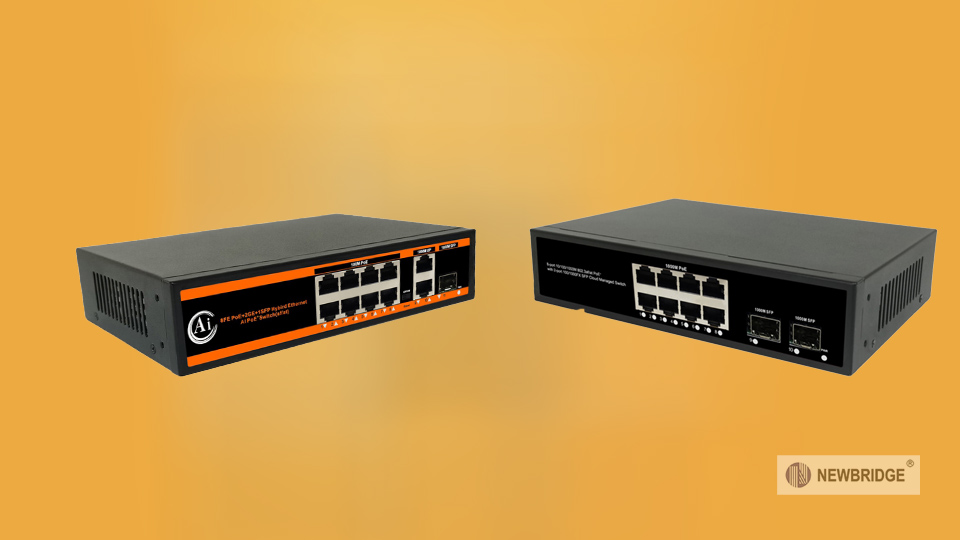In the selection of network devices, the difference between PoE switches and regular switches often confuses users. The core difference between the two lies in whether they support supplying power to terminal devices through Ethernet cables. This functional difference gives rise to different application scenarios and technological advantages. Below is a detailed analysis for you.

1、 Basic Definition and Technical Principles
(1) PoE switch
PoE (Power over Ethernet) switches follow the IEEE 802.3af/at standard and can simultaneously transmit data and power through 4/5/7/8 cores or 1/2/3/6 cores of Ethernet cables. They support power supply for devices such as IP phones, wireless APs, and network cameras. Depending on the standard, the maximum power supply for 802.3af is about 15.4W, and for 802.3at it can reach about 30W
(2) Ordinary switch
Ordinary switches are only responsible for forwarding and exchanging data signals, and terminal devices need to be separately connected to power adapters, relying on external power supply systems and unable to transmit power through network cables.
2、 Comparison of core differences
(1) Power supply capability
PoE switch: Integrated power supply module, no need to deploy additional power cables for terminals, reducing wiring complexity, especially suitable for scenarios where power access is inconvenient such as ceilings and walls.
Ordinary switch: No power supply function, each terminal needs to be connected to a nearby power outlet, and both network and power cables need to be considered when wiring, resulting in higher construction costs and complexity.
(2) Cost structure
PoE switch: The hardware cost is higher than ordinary switches (due to the built-in power supply module), but long-term use can save power lines, sockets, and construction costs, making it suitable for large-scale device deployment.
Ordinary switch: The initial procurement cost is relatively low, but if the terminal equipment requires additional power supply, the overall wiring cost may exceed the PoE solution.
(3) Application scenarios
PoE switch: suitable for scenarios such as security monitoring (cameras), smart office (IP phones), smart home (wireless APs) that require "plug and play" and have difficulty deploying power, especially suitable for building renovation projects.
Ordinary switch: more suitable for centralized power management environments such as data centers and computer rooms, or scenarios where terminal devices already have independent power supply (such as computers and servers).
(4) Compatibility and Scalability
PoE switch: The terminal device needs to support PoE power (such as labeled "PoE Compatible"), and some models support Auto MDI/MDIX, with compatibility gradually improving.
Ordinary switches: have stronger compatibility, do not need to consider terminal power supply requirements, can flexibly match various devices, but scalability is limited by power layout.
3、 The core advantages of PoE switches
(1) Simplify wiring and installation
Unified transmission of data and power through network cables to avoid mixing of power lines and network cables and reduce construction difficulty. For example, when deploying surveillance cameras in shopping malls, PoE switches allow the cameras to be directly installed on the ceiling without the need for additional slotted power cords.
(2) Enhance environmental safety
Reduce safety hazards such as short circuits and tripping caused by exposed power cords, especially suitable for places with high safety requirements such as hospitals and schools. Meanwhile, centralized power supply facilitates unified management and enables remote restart of faulty devices through switches.
(3) Support flexible deployment
For temporary office locations, exhibition sites, and other scenarios, PoE switches can quickly set up networks and power supply systems without the need to modify existing power lines. If wireless APs are temporarily deployed during the exhibition, simply connect a PoE switch to achieve network coverage and power supply.
(4) Energy saving and intelligent management
Some PoE switches support dynamic power allocation, adjusting power supply according to terminal needs to avoid energy waste. In conjunction with network managed PoE switches, real-time monitoring of the power supply status of each port can be achieved, enabling remote operation and maintenance.
4、 Applicable scenarios of ordinary switches
(1) Low cost small-scale network
In scenarios such as home LANs and small offices, if terminal devices (such as computers and routers) are independently powered, ordinary switches can meet data transmission needs with lower procurement costs.
(2) High power equipment access
When the power of the terminal device exceeds the PoE standard (such as some industrial grade APs requiring more than 60W of power), it is necessary to pair it with a regular switch and an independent power adapter to ensure stable power supply.
(3) Environment with existing power planning
In newly built buildings or data centers, if the power sockets have been accurately arranged according to the terminal positions, ordinary switches can efficiently cooperate with the existing power supply system without the need for additional PoE devices.
5、 Choose Suggestions
If you need to deploy devices such as IP phones, cameras, wireless APs, etc. in a centralized manner and want to simplify wiring, prioritize choosing PoE switches (such as models that support 802.3at).
If the network scale is small, the terminal devices have independent power supply, or high-power devices need to be connected, ordinary switches are more cost-effective.
Large enterprises can consider a hybrid network of "PoE switches+regular switches", where the core layer uses PoE to support critical devices and the access layer uses regular switches to reduce costs.
In short, there is no absolute advantage or disadvantage between PoE switches and regular switches. The key is to match the power supply requirements and cost budget of actual application scenarios. If you need to further understand the technical parameters of specific models, you can visit the official website of professional network equipment manufacturers to obtain detailed information.
